You know what’s wild? Loki has gone from being this relatively obscure Norse trickster god to basically everyone’s favorite complicated villain-turned-hero. I mean, when’s the last time you saw someone cosplay as Odin versus Loki? According to Marvel’s character database, Loki has undergone one of the most dramatic character transformations in modern mythology, evolving from a simple trickster to the “God of Stories” who literally rewrites his own narrative destiny (https://www.marvel.com/characters/loki/in-comics).
This reminds me of my own journey with Norse mythology – I started reading these stories expecting simple good-versus-evil tales, but Loki’s complexity completely changed how I understood storytelling itself. I remember the first time I read about Loki cutting off Sif’s hair and thinking “what an idiot.” But then I realized – haven’t we all done something impulsive that spiraled way out of control? His ability to exist simultaneously as villain, hero, and catalyst showed me that the most compelling characters resist easy categorization.
Table of Contents
-
What Makes a Great Loki God of Stories Interpretation
-
25 Top Loki God of Stories Across 6 Categories
-
Literary Works (5 entries)
-
Visual Media & Entertainment (5 entries)
-
Academic & Scholarly Resources (4 entries)
-
Interactive & Gaming Experiences (4 entries)
-
Creative Tools & Resources (4 entries)
-
Modern Interpretations & Adaptations (3 entries)
-
-
Detailed Analysis of Standout Entries
-
How to Choose the Right Loki Interpretation for You
-
Practical Applications for Writers and Creators
-
Final Thoughts
TL;DR
-
Loki’s like that friend who’s incredibly smart and fun to be around, but you know they’re going to drag you into some drama eventually – and somehow you love them anyway because life’s more interesting with them around
-
The best Loki interpretations don’t try to resolve his contradictions – they embrace them, showing how someone can be simultaneously helpful and destructive, intelligent and self-sabotaging
-
Tom Hiddleston basically turned a B-list Marvel villain into the internet’s boyfriend – if that’s not the power of good storytelling, I don’t know what is
-
Different formats excel at different things: books let you get inside his twisted psychology, movies give you that emotional punch, games let you make those morally gray choices yourself
-
The academic stuff grounds everything in real history, while creative tools help you develop your own Loki-inspired characters without just copying what’s already been done
-
Writers can learn from Loki’s structure to create compelling antiheroes who serve multiple story functions at once – catalyst, mirror, challenger, and transformer all rolled into one messy, fascinating package
What Makes a Great Loki God of Stories Interpretation
Look, I’ve consumed way too much Loki content over the years, and let me tell you – not all interpretations are created equal. Some will have you staying up until 3 AM diving deep into Norse mythology rabbit holes, while others will leave you wondering why you bothered.
Here’s what I’ve learned separates the amazing Loki stories from the forgettable ones:
It’s gotta feel authentic to the mythology – and I don’t mean it needs to be a word-for-word retelling of the Eddas (trust me, those can be a slog). But the best versions keep that essential Loki DNA – the cleverness, the chaos, the way he’s simultaneously helpful and destructive. When creators completely ignore the mythological roots, you end up with just another generic trickster character who happens to be named Loki.
Understanding these storytelling principles becomes even more crucial when examining powerful story theme examples that explore transformation and identity, themes central to Loki’s character development across different mediums.
|
What Makes It Work |
Excellent |
Good |
Skip It |
|---|---|---|---|
|
Mythological Connection |
Keeps the essential Loki DNA while innovating |
Some connection with moderate creativity |
Generic trickster with Loki’s name slapped on |
|
Character Complexity |
Embraces contradictions and makes them feel human |
Shows some depth but misses key aspects |
One-dimensional villain or perfect antihero |
|
Thematic Depth |
Explores identity, transformation, family dysfunction |
Touches on meaningful themes |
Just surface-level entertainment |
|
Cultural Impact |
Changes how people think about the character |
Resonates with specific audiences |
Forgettable within a week |
|
Medium Use |
Maximizes what that format does best |
Uses the medium effectively |
Doesn’t leverage the format’s strengths |
|
Accessibility |
Right level for intended audience |
Mostly accessible with some barriers |
Requires a mythology degree to enjoy |
Complex doesn’t mean confusing – Loki should make your brain work a little. He’s not your typical villain twirling his mustache, and he’s definitely not a straightforward hero either. The interpretations that really stick with you show him as genuinely intelligent and emotionally complicated. You should understand why he does what he does, even when you’re yelling at him to make better choices.
Here’s something I’ve noticed: the medium really matters. Books let you get inside his head and understand those twisted thought processes. Movies and TV shows give you that emotional punch through great acting (looking at you, Tom Hiddleston). Games let you actually make some of those morally gray choices yourself. Each format brings out different aspects of what makes Loki fascinating.
Consider how Neil Gaiman’s “Norse Mythology” uses the literary medium to show Loki’s internal thought processes during his schemes. When Loki cuts off Sif’s hair as a prank, Gaiman doesn’t just describe the action – he reveals Loki’s impulsive nature, his failure to consider consequences, and his genuine panic when he realizes the severity of Thor’s anger. This psychological insight would be difficult to convey as effectively in visual media, where external actions take precedence over internal states.
And honestly? The best Loki stories make you think about bigger stuff – identity, whether people can really change, what family means when it’s complicated. If you’re just getting surface-level entertainment, you’re missing out on why this character has stuck around for over a thousand years.
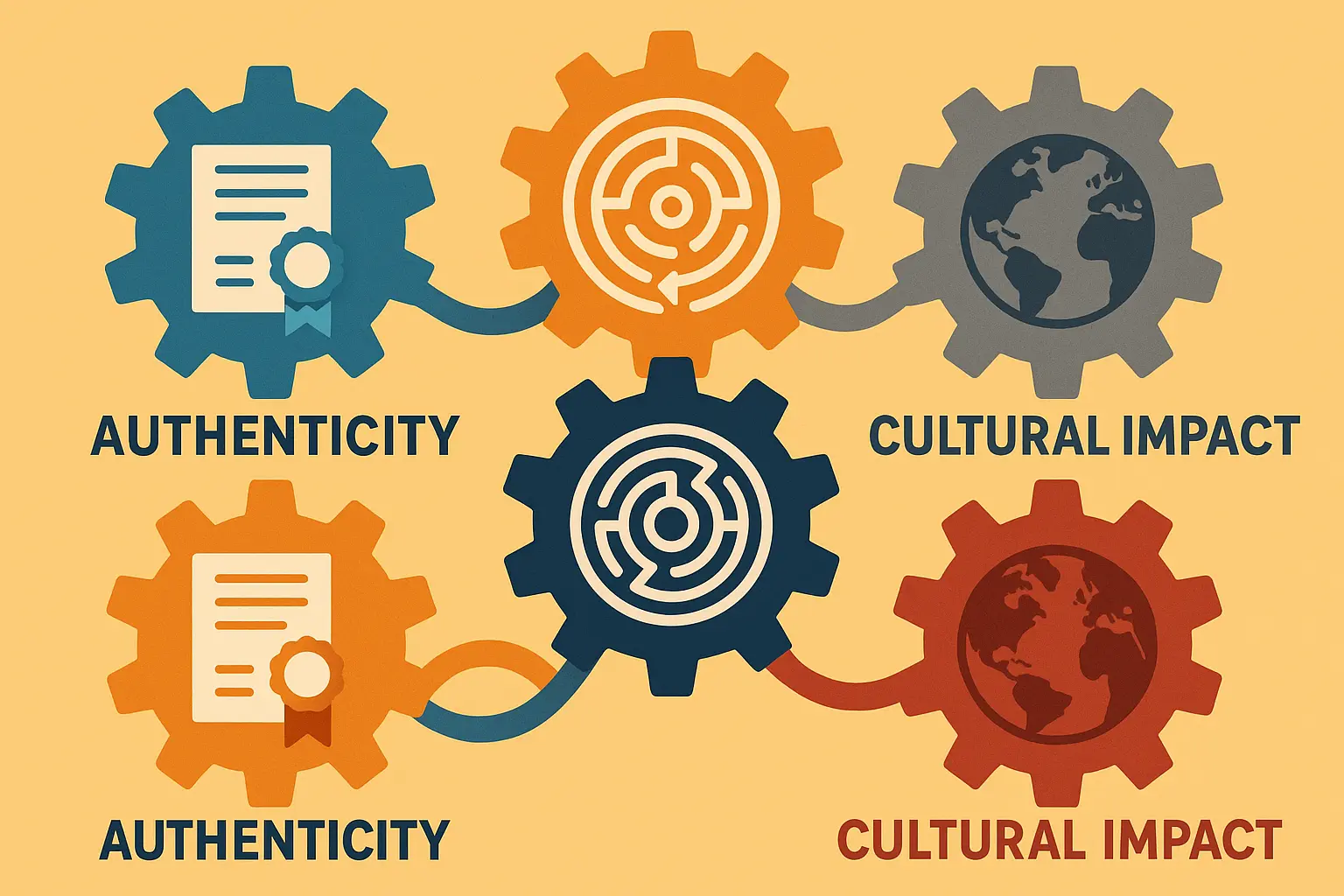
25 Top Loki God of Stories Across 6 Categories
Alright, I’ve organized this massive list into six categories because there’s seriously so much good Loki content out there, it can be overwhelming. Whether you’re a reader, a binge-watcher, a gamer, or someone who likes to dig into the academic stuff, there’s something here for you.
Literary Works
1. Neil Gaiman’s “Norse Mythology” – Loki Reimagined
Okay, I know everyone recommends this book, but there’s a reason for that. Gaiman takes these ancient stories that can feel pretty alien to modern readers and makes them feel like they could happen in your neighborhood – if your neighborhood had gods running around causing problems.
His Loki is absolutely magnetic. You know he’s going to screw things up spectacularly, but you can’t help rooting for him anyway. Gaiman nails that thing where Loki genuinely cares about the other gods, even as he’s setting up their destruction. It’s like watching your charismatic but self-destructive friend make the same mistakes over and over.
What really gets me is how Gaiman structures the whole thing. Each story seems standalone, but Loki’s actions ripple through everything. It’s exactly how consequences work in real life – that stupid thing you did three months ago suddenly comes back to bite you when you least expect it.
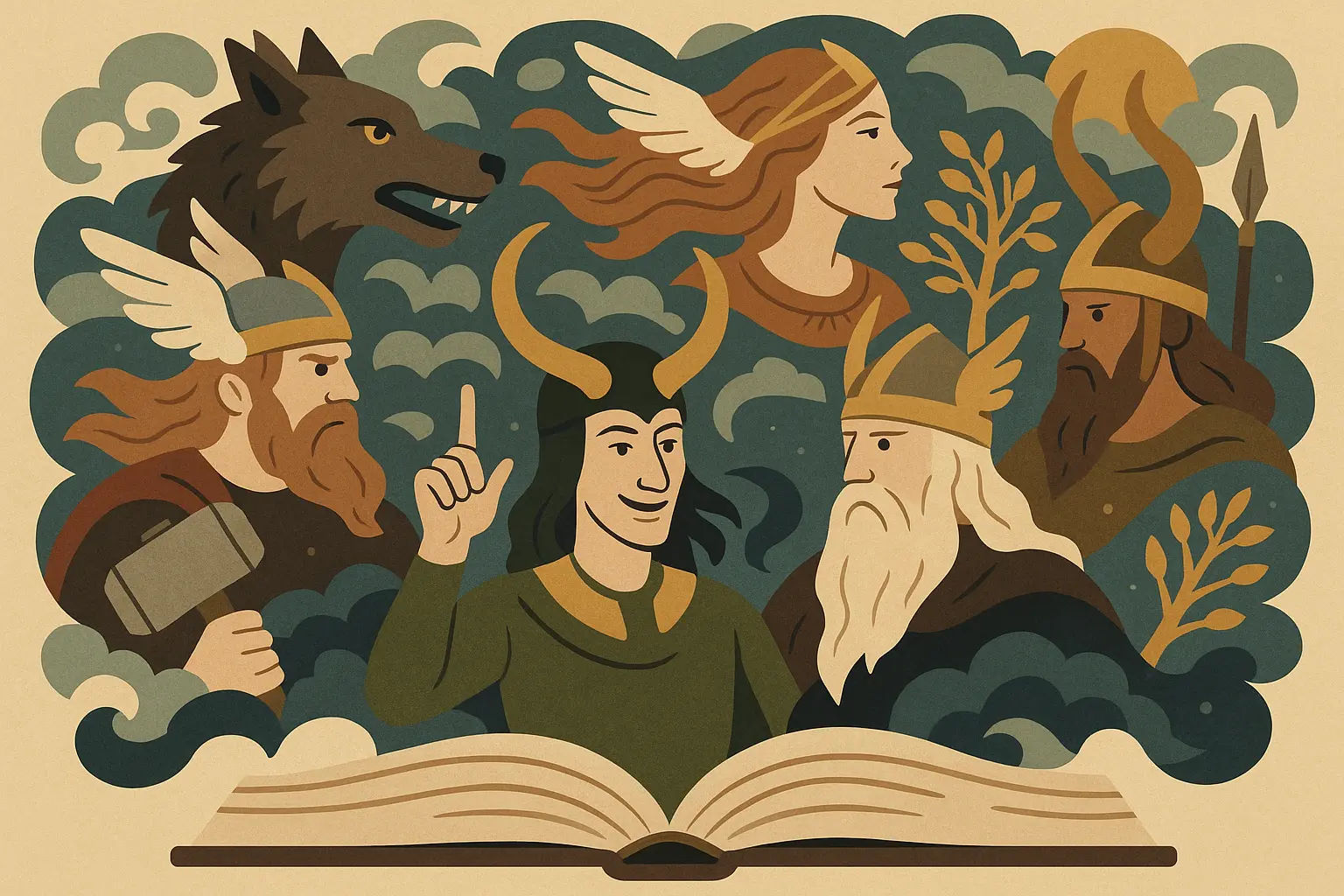
2. Rick Riordan’s “Magnus Chase” Series – Modern Loki
If you’ve read Percy Jackson, you know Riordan’s deal – he takes mythology and drops it into the modern world in ways that somehow make perfect sense. His Loki is fascinating because he’s not the main character, but he’s the one teaching Magnus the most important lessons.
Riordan’s approach demonstrates how folktale story examples can be modernized while preserving their essential wisdom and transformative power.
This version of Loki gets that identity is basically a story we tell ourselves, and we have the power to rewrite that story. It’s surprisingly deep for a YA series. Plus, Riordan doesn’t shy away from the fact that Loki’s “lessons” often come with a hefty price tag.
The books work great if you want Norse mythology that feels relevant to actual teenage problems – figuring out who you are, dealing with complicated family situations, learning that adults are just as messed up as everyone else.
3. Joanne Harris’s “The Gospel of Loki” – First-Person Narrative
This one’s a trip. Harris lets Loki tell his own story, and boy, is he an unreliable narrator. You’re getting his version of events, complete with all his justifications and blind spots. It’s like getting relationship advice from your friend who’s definitely not telling you the whole story about their breakup.
What makes this brilliant is that Harris shows you Loki’s intelligence and charm while also showing you how he uses those qualities to manipulate situations (and himself). He knows he’s heading toward his own destruction, but he can’t seem to stop himself. It’s tragic and infuriating at the same time.
If you’re the type who likes psychological deep dives into character motivation, this book will keep you up at night analyzing every interaction.
4. Marvel Comics’ “Loki: Agent of Asgard” – Redemption Arc
Here’s where Marvel gets really clever with the “God of Stories” concept. This Loki literally understands that in the Marvel universe, reputation shapes reality. So he’s actively trying to rewrite his story by doing heroic things, but everyone expects him to be the villain.
It’s meta as hell – Loki knows he’s fictional and is trying to change his narrative role. The comic explores how incredibly hard it is to change when everyone around you expects you to stay the same. Ever tried to break out of the role your family cast you in? Yeah, it’s like that, but with cosmic consequences.
Writer Al Ewing creates a Loki who genuinely wants to be better while acknowledging that being bad is often easier and more fun. The character development feels earned because it shows how much work real change requires.
5. “American Gods” by Neil Gaiman – Cultural Evolution
Gaiman’s American Loki is a survivor who gets that gods need to adapt or become irrelevant. This version shows up in modern America and basically goes, “Okay, how do I make trickster energy work in a country built on reinvention?”
What’s brilliant about this take is how it positions Loki as perfectly suited to American culture. We’re a country obsessed with the idea that you can reinvent yourself, that your past doesn’t have to define your future. Loki’s shapeshifting abilities become a metaphor for the American Dream – for better and worse.
The book makes you think about how ancient stories find new life in different cultures. Loki doesn’t become less mythologically significant; he becomes more relevant.
Visual Media & Entertainment
6. Marvel Cinematic Universe Loki – Character Development
Let’s be real – Tom Hiddleston turned what could have been a forgettable villain into one of the most beloved characters in modern cinema. His Loki goes from “angry younger brother with daddy issues” to someone who can put aside personal grudges for the greater good.
What Hiddleston nails is Loki’s fundamental loneliness. You see this incredibly intelligent, powerful being who just wants to belong somewhere, but his nature keeps sabotaging his relationships. It’s heartbreaking and relatable even when he’s doing terrible things.
The MCU shows how character development can happen across multiple movies while staying consistent. Each appearance adds new layers without contradicting what came before. It’s a masterclass in long-term storytelling.
The evolution of Loki’s character arc across the MCU demonstrates masterful long-term storytelling. In “Thor” (2011), Loki’s motivations stem from sibling rivalry and feelings of inadequacy. By “Thor: Ragnarok” (2017), he’s evolved into someone who can put aside personal grievances for the greater good, culminating in his sacrifice in “Avengers: Infinity War” (2018). This progression shows how character development can occur across multiple films while maintaining consistency.
7. “Loki” Disney+ Series – Multiverse Storytelling
The Disney+ show uses the multiverse to ask some genuinely deep questions: If you met different versions of yourself, would you like them? Are you defined by your choices or your circumstances? Can you really change, or are you always going to be fundamentally the same person?
What’s clever is how the show uses the Time Variance Authority as a metaphor for narrative control. It’s asking whether we have free will or if we’re just following a predetermined script. Heavy stuff for a superhero show, but it works because it’s grounded in character relationships.
The series really commits to the idea that understanding you’re fictional doesn’t make you less real – it might actually give you more power to change your story.
8. “God of War” Video Game Series – Norse Mythology Gaming
Sony’s 2018 “God of War” does something really smart – it lets you experience Loki’s story (through Atreus) without the baggage of preconceptions. You’re watching this kid discover his powers and identity alongside his father, and the gradual revelation hits different when you’ve been invested in the relationship.
The game excels at showing how learning about your mythological role affects your behavior. Atreus starts changing as he discovers his trickster nature, and you feel the impact on his relationship with Kratos. It’s family drama with mythological stakes.
What makes this work so well is the interactive element. You’re not just watching character development; you’re participating in it through gameplay. When A treus starts getting cocky with his powers, you feel the consequences through the game mechanics.
9. “The Sandman” Netflix Series – Storytelling Metaphysics
Okay, so this doesn’t actually feature Loki, but stick with me. “The Sandman” explores the same themes that make Loki compelling as the God of Stories – how narratives shape reality, how mythological beings embody concepts bigger than individual personality.
The show’s sophisticated approach to narrative construction offers insights similar to those found in short story examples that explore the power of storytelling to transform reality and perception.
The show’s treatment of Dream and the other Endless gives you a framework for understanding how Loki functions as a living story concept. Both characters have to balance personal desires against cosmic responsibilities, and sometimes that means doing things that seem cruel or contradictory.
If you want to understand the deeper implications of what it means to be a “God of Stories,” this series provides the philosophical foundation.
10. “Thor: Ragnarok” – Comedic Trickster
Taika Waititi figured out how to make Loki genuinely funny without undermining his dramatic weight. This version uses humor to explore his relationship with Thor and his role in Asgard’s destruction and renewal.
What works is that Loki’s jokes often mask deeper emotions. His quips and schemes serve character development, not just comic relief. You laugh with him, but you also see the pain underneath.
The film shows Loki accepting his role in Ragnarök not as a villain destroying everything out of spite, but as someone who understands that sometimes you have to tear things down before you can build something better.
Academic & Scholarly Resources
11. “The Prose Edda” by Snorri Sturluson – Original Source
Look, I’m not going to lie to you – this is a tough read. Snorri wrote this in the 13th century, and it shows. But if you want to understand where all these modern interpretations come from, this is ground zero.
Sturluson’s Loki is all contradictions – he helps the gods get their greatest treasures, but he’s also setting up their destruction. This version established the template everyone else works from: Loki as necessary chaos, the outsider who’s essential but ultimately incompatible with ordered society.
The psychological insights are surprisingly modern. Sturluson gets how Loki’s intelligence and outsider status make him both valuable and dangerous. If you can push through the archaic language, there’s real wisdom here about human nature and social dynamics.
12. “Loki in Scandinavian Mythology” by Jan de Vries – Academic Analysis
De Vries does the heavy lifting of tracing how Loki evolved through different historical periods and cultural contexts. It’s academic writing, so don’t expect beach reading, but it’s fascinating if you want to understand how mythological figures adapt to serve different cultural needs.
The book shows how different eras emphasized different aspects of Loki’s character – sometimes the helpful trickster, sometimes the destructive force. It’s like seeing how the same person gets described differently by various friends and enemies.
This is essential reading if you want to understand which elements of modern Loki interpretations are traditional versus innovative. It gives you the historical grounding to evaluate contemporary adaptations.
13. “The Viking Way” by Neil Price – Archaeological Context
Price approaches Norse mythology through archaeology and material evidence, which gives you a different perspective on how these stories actually functioned in historical society. It’s not just about the myths themselves, but how they reflected real cultural tensions and practices.
The book shows how Loki’s mythological role mirrored genuine social needs – the balance between stability and necessary change, order and creative chaos. Trickster figures weren’t just entertainment; they served important psychological and social functions.
If you want to ground your understanding of Loki in historical reality rather than just storytelling, this book provides crucial context about what these myths meant to the people who originally told them.
14. “Norse Mythology: A Guide to Gods, Heroes, Rituals, and Beliefs” by John Lindow – Reference Work
This is your go-to reference book. Lindow doesn’t just focus on individual gods; he shows how they all fit together in a coherent mythological system. For Loki, this means understanding how his trickster role interacts with Thor’s strength, Odin’s wisdom, and Frigg’s protection.
The book excels at making scholarly insights accessible without dumbing them down. Lindow explains complex concepts clearly and provides the context you need to understand why these stories still matter.
If you’re serious about understanding Norse mythology beyond pop culture interpretations, this book gives you the foundation to build on.
Interactive & Gaming Experiences
15. “Assassin’s Creed Valhalla” – Historical Fiction Gaming
Ubisoft does something interesting here – they integrate mythological elements into a historically grounded Viking Age setting. You get to experience how Norse people might have understood and interacted with figures like Loki as part of their actual religious and cultural system.
The game’s strength is its educational component. You learn about real Viking Age society while experiencing mythological narratives. It shows how these stories functioned as living cultural elements rather than just entertainment.
The historical context makes the mythological elements feel more grounded and meaningful. When you encounter Loki-related content, it’s within a framework of actual Norse culture and beliefs.
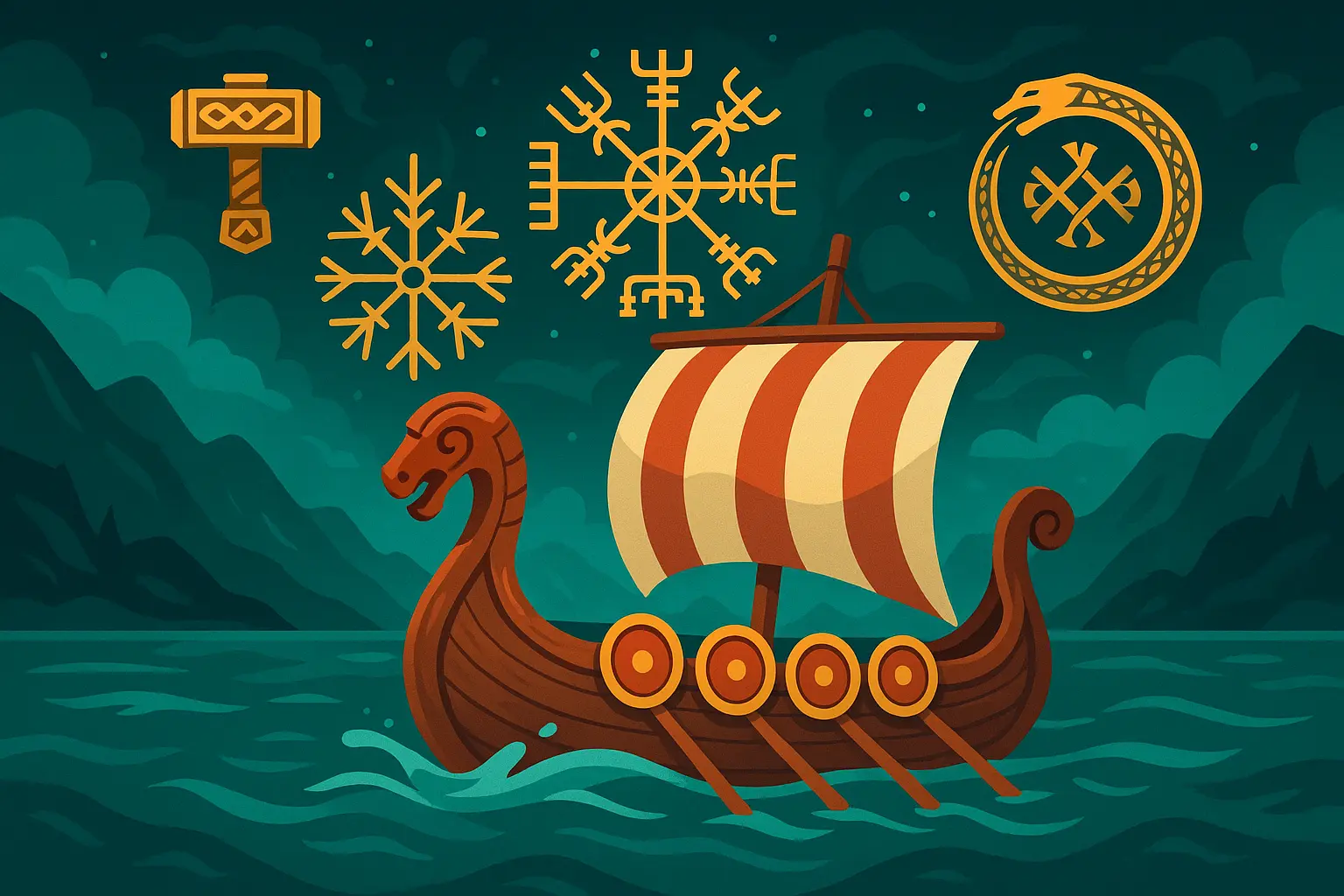
16. “Hades” Video Game – Mythological Storytelling Mechanics
Okay, this is Greek mythology, not Norse, but hear me out. “Hades” shows how video games can excel at mythological storytelling through character development, family dynamics, and thematic depth. It’s a template for how Norse mythology games could handle similar material.
The game treats mythological figures as complex characters with real emotions and relationships, not just powerful beings with cool abilities. It explores family dysfunction, generational trauma, and personal growth within a mythological framework.
The mechanics reinforce the themes – repeated attempts and failures mirror the cyclical nature of mythological narratives. This approach would work perfectly for Loki stories, where his repeated schemes and their consequences could be explored through gameplay loops.
17. “Crusader Kings III” Norse DLC – Strategy Gaming
This game lets you play characters who share Loki’s trickster characteristics within a complex political simulation. You get to experience how cunning, deception, and strategic thinking actually work within historical contexts.
What’s valuable is experiencing the practical implications of Loki-like behavior. You see how trickster tactics can achieve short-term gains while creating long-term problems. The simulation shows why figures like Loki are simultaneously useful and dangerous.
Rather than just telling stories about trickster figures, the game lets you experience the decision-making processes and consequences that define such characters. It’s a unique way to understand mythological archetypes.
18. Tabletop RPG Sourcebooks – “RuneQuest: Glorantha”
Tabletop RPGs provide frameworks for incorporating trickster deities into collaborative storytelling. These materials show how mythological figures can be adapted for interactive narrative creation while keeping their essential characteristics.
The sourcebooks excel at providing mechanical systems that reflect mythological themes. Trickster characters get abilities that mirror their narrative functions – shapeshifting, illusion, social manipulation – while facing appropriate consequences.
What makes tabletop RPGs particularly valuable is their collaborative nature. Players and game masters work together to create stories that honor mythological traditions while allowing creative innovation.
Creative Tools & Resources
19. Mythology-Based Writing Prompts – Story Inspiration
Good writing prompts don’t just suggest surface-level adaptations – they encourage exploration of deeper themes that make Loki compelling. They focus on transformation, moral ambiguity, the power of stories, and the role of chaos in ordered systems.
These prompts work particularly well when combined with understanding how to write a story using brain science principles, helping writers create psychologically compelling characters that resonate with readers on a deeper level.
These resources work best when they help you understand mythological storytelling techniques rather than just providing plot ideas. They serve as inspiration for stuck writers, educational tools for understanding narrative structure, and frameworks for developing original characters.
A well-crafted prompt might ask you to explore how someone who can rewrite their own memories deals with unexpected consequences, capturing Loki’s role as both creator and destroyer of stories without requiring direct adaptation.
20. Character Development Worksheets – Loki Archetype
These worksheets help you create complex, morally ambiguous characters who can serve multiple narrative functions simultaneously. They break down the essential elements that make Loki compelling across different interpretations.
The focus is on developing characters who embody contradictions – helpful yet harmful, intelligent yet self-destructive, charming yet dangerous. They provide structured approaches to creating motivations that make sense from the character’s perspective while acknowledging potential harm.
What makes these resources valuable is their emphasis on narrative function. They help you understand how trickster characters serve stories as catalysts for change, mirrors reflecting other characters’ flaws, and agents of transformation.
21. World-Building Guides – Norse-Inspired Fantasy
These guides help you create original settings that capture Norse mythology’s appeal while developing unique mythological systems. They focus on understanding the functions mythological figures serve rather than just their surface characteristics.
The guides help you create trickster deities who serve similar narrative and thematic purposes as Loki while fitting organically into original mythological frameworks. They’re valuable for writers who want to capture the essence of Norse mythology without doing direct adaptations.
These resources show you how mythological systems actually work – how different types of figures interact to create compelling narrative possibilities. It’s not just about individual characters, but about building entire cosmologies that feel authentic and lived-in.
22. Storytelling Frameworks – Trickster Narratives
These frameworks give you structural templates for stories that effectively use Loki-inspired characters. They focus on how trickster figures drive narrative development and create meaningful conflict without just causing random chaos.
These frameworks complement broader story examples that demonstrate how complex characters can serve multiple narrative functions while maintaining reader engagement and emotional investment.
The frameworks emphasize how trickster characters serve as catalysts – their actions force other characters to grow, change, or reveal their true natures. They help you balance the chaos tricksters bring with the structure necessary for coherent storytelling.
What makes these particularly useful is their focus on thematic integration. They show you how trickster characters can embody themes of transformation, identity, and moral ambiguity while creating narratives that work on multiple levels simultaneously.
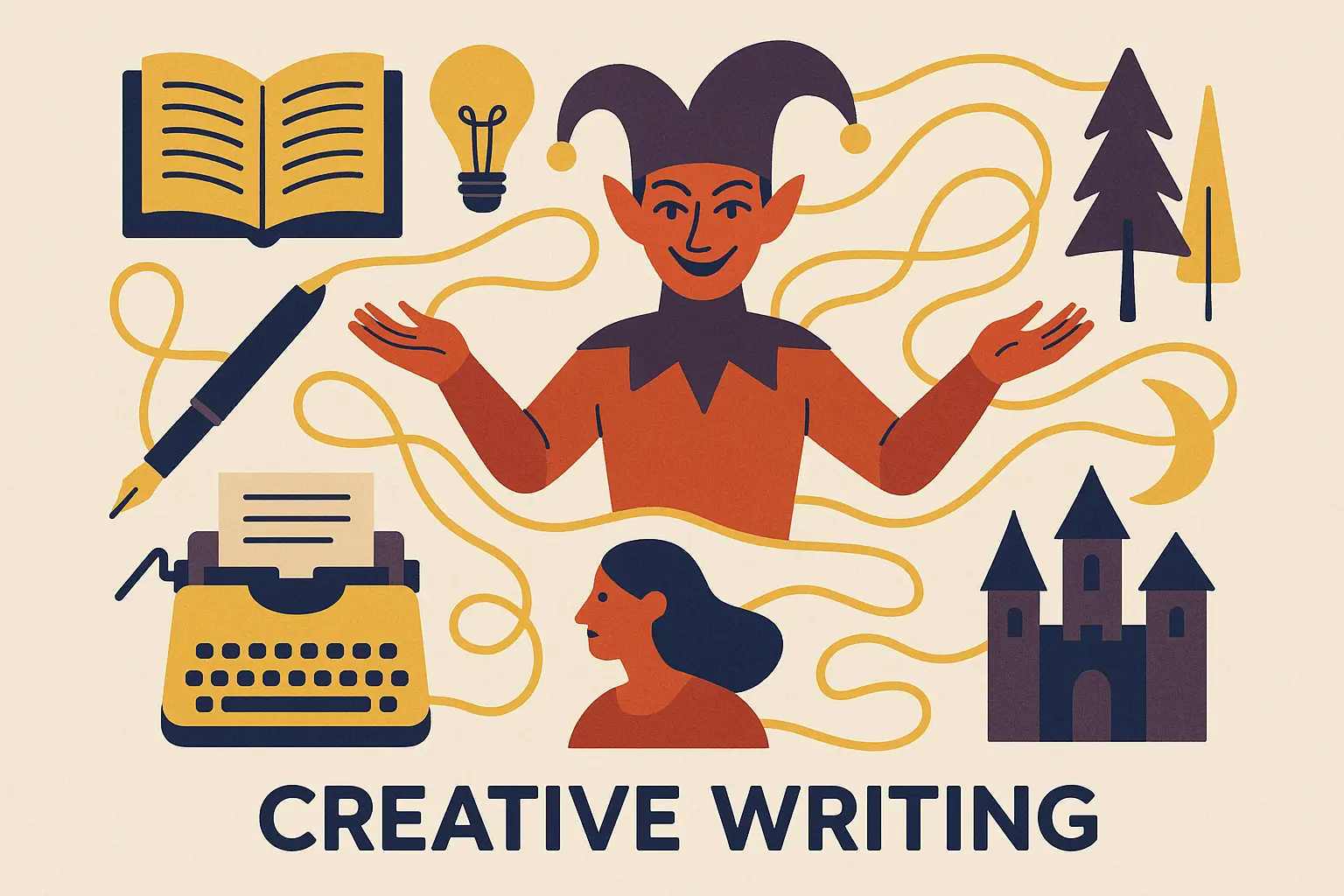
Modern Interpretations & Adaptations
23. Podcast Series – “Myths and Legends”
Jason Weiser’s “Myths and Legends” podcast is perfect if you want Norse mythology explained like you’re hanging out with a really knowledgeable friend. Weiser connects ancient stories to modern concerns without talking down to his audience or oversimplifying complex concepts.
The episodes on Loki are particularly good at showing how these thousand-year-old stories address timeless human experiences – family dysfunction, wanting recognition, the consequences of being too clever for your own good. Weiser makes it clear why these stories still matter.
What I love about the podcast format is how it allows for detailed analysis while staying entertaining. You get historical context, different interpretations, and insights into how these myths continue influencing modern culture.
24. Webcomics – “Stand Still. Stay Silent”
Minna Sundberg’s webcomic shows how Norse mythology can be woven into contemporary storytelling in ways that feel both familiar and startlingly relevant. She creates a post-apocalyptic world where mythological concepts address modern anxieties about environmental collapse and social fragmentation.
The visual storytelling captures the atmospheric qualities of Norse mythology – that sense of impending doom, the beauty and danger of the natural world, the complex relationships between different cultural groups. Mythological elements feel organic rather than forced.
What makes this particularly valuable is Sundberg’s cultural authenticity. Drawing on her Nordic background, she creates a world that feels genuinely connected to Scandinavian culture while telling a completely original story that speaks to contemporary concerns.
25. Fan Fiction Communities – Archive of Our Own
Look, I know fan fiction gets a bad rap sometimes, but platforms like AO3 host thousands of Loki interpretations that explore every conceivable aspect of his character. These communities show how mythological figures can be endlessly reinterpreted while maintaining their essential appeal.
Fan fiction excels at exploring aspects of Loki’s character that mainstream media might not have time for. Writers create intimate character studies, explore relationships in depth, and experiment with different interpretations of his motivations and psychology.
What’s particularly valuable is the diversity of perspectives. Writers from different backgrounds bring their own experiences to Loki’s character, creating interpretations that reflect contemporary concerns about identity, family, redemption, and belonging while honoring the source material.
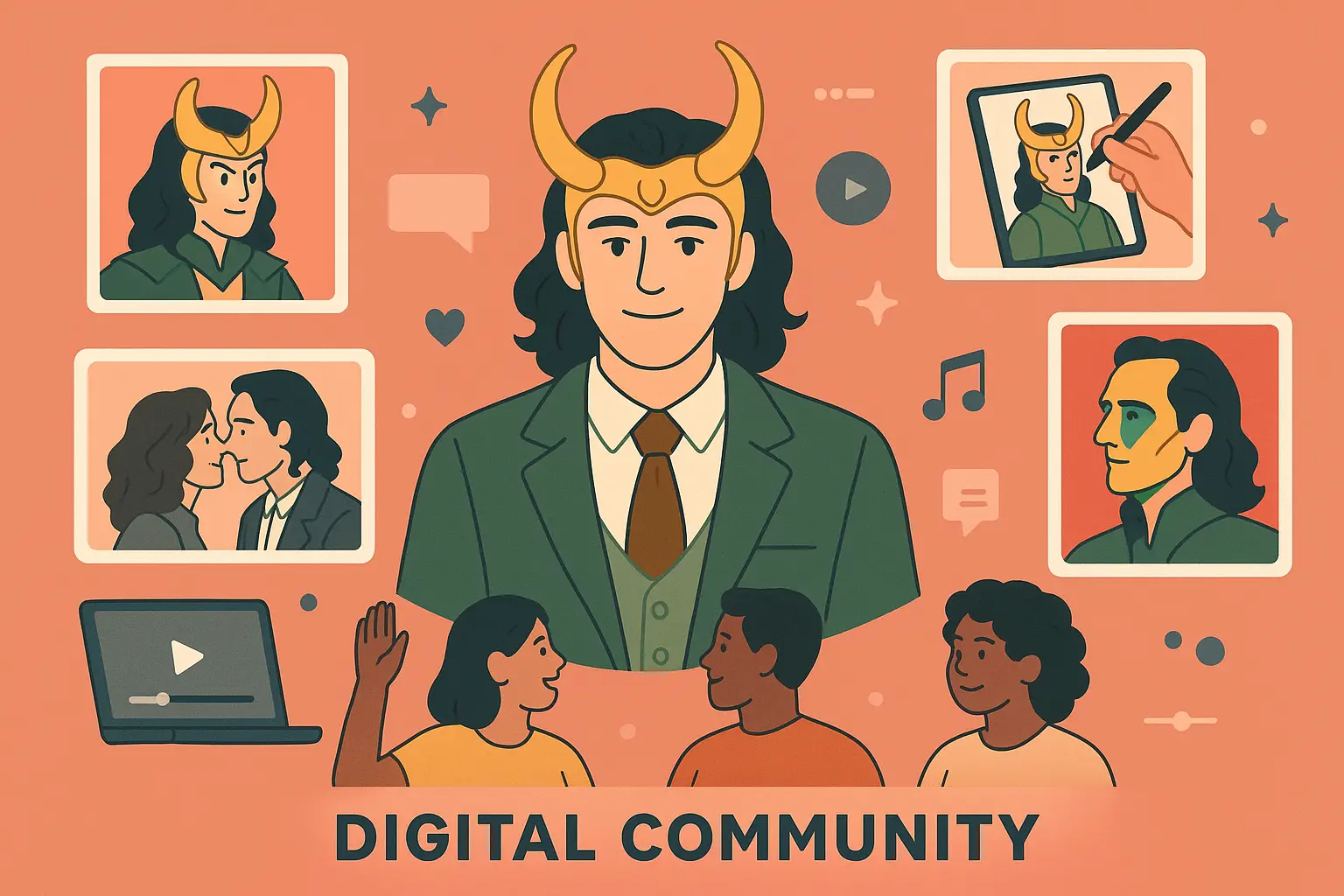
Detailed Analysis of Standout Entries
Why These Work So Well
After diving deep into all these interpretations, a few things become crystal clear about what separates the memorable Loki stories from the forgettable ones.
Neil Gaiman’s “Norse Mythology” works because Gaiman understands that accessibility doesn’t mean dumbing things down. His Loki feels both ancient and contemporary – you get the mythological weight without needing a PhD in Old Norse to appreciate it. The way he structures the book mirrors how Loki actually functions in the myths: every story seems standalone until you realize how interconnected everything is.
The MCU’s approach succeeds because they committed to character development over multiple films. Tom Hiddleston’s performance captures something essential about Loki – that desperate need to belong combined with behavior that pushes people away. It’s psychologically honest in a way that makes the fantastical elements feel grounded.
“God of War” (2018) is brilliant because it lets you discover Loki’s identity alongside Atreus. You’re not watching from the outside; you’re experiencing the confusion, the growing power, the changing relationships. The interactive element makes the character development feel personal rather than just observed.
What They All Share
The best interpretations share some key elements that make them stick with you:
They all treat Loki as genuinely intelligent, not just cunning. There’s a difference between a character who’s clever and one who’s actually wise (even if he doesn’t always act on that wisdom). The compelling versions show Loki understanding consequences even when he can’t stop himself from causing them.
They balance sympathy with accountability. You understand why Loki does what he does without excusing the harm he causes. The best versions make you care about him while acknowle dging that caring about someone doesn’t mean enabling their destructive behavior.
They use Loki’s trickster nature to explore bigger themes. Whether it’s identity, family dysfunction, the nature of change, or the power of stories themselves, the memorable interpretations use his character to examine universal human experiences.
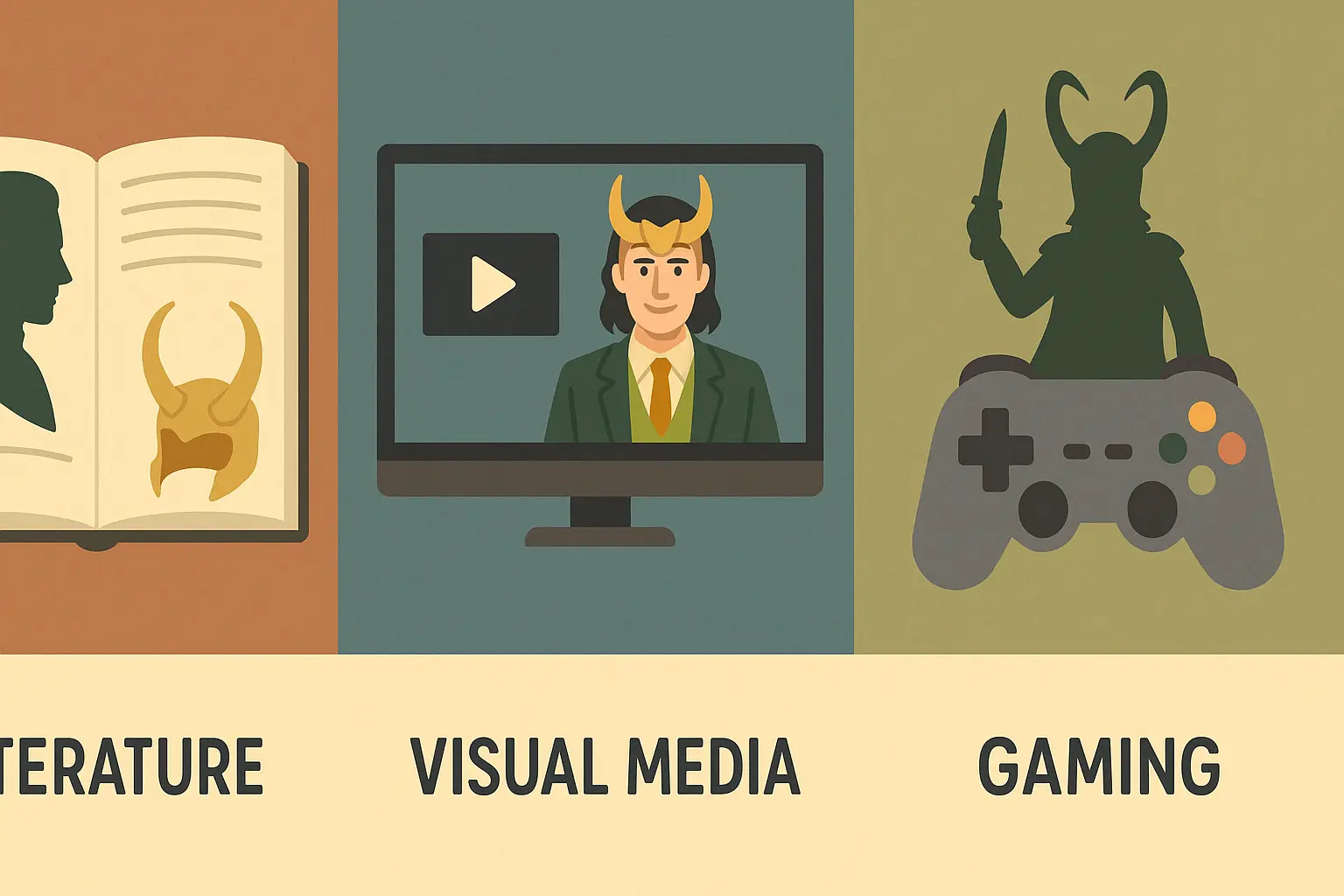
How to Choose the Right Loki Interpretation for You
Here’s the thing – with this much Loki content out there, you don’t need to consume everything. Life’s too short, and honestly, some interpretations will click with you while others won’t, and that’s totally fine.
If you’re new to Norse mythology, start with Neil Gaiman’s “Norse Mythology.” It’s accessible without being simplistic, entertaining without losing the mythological weight. You’ll get the background you need for everything else without feeling like you’re doing homework.
If you’re a visual person, the Marvel stuff is your best bet. Start with the first “Thor” movie and work your way through the MCU. Tom Hiddleston’s performance will give you an emotional connection to the character that makes exploring other interpretations more rewarding.
If you like getting inside characters’ heads, go for “The Gospel of Loki” by Joanne Harris. First-person narration from Loki himself is as intimate as it gets. Just remember he’s not exactly a reliable narrator.
If you’re a gamer, “God of War” (2018) provides an interactive way to experience Norse mythology that feels both authentic and emotionally engaging. The father-son dynamic adds layers you won’t find in other interpretations.
If you want the academic foundation, start with John Lindow’s reference guide, then work your way up to “The Prose Edda” if you’re feeling ambitious. Fair warning – the original sources require patience, but they’re worth it if you want to understand where everything else comes from.
If you’re a writer looking for inspiration, check out the Marvel comics, especially “Loki: Agent of Asgard.” The meta-textual elements and focus on narrative agency provide great insights into character development and thematic exploration.
Don’t feel like you have to start with the “most important” or “most authentic” versions. Start with what interests you, then branch out from there. Your enthusiasm will carry you through material that might otherwise feel like work.
|
Your Style |
Start Here |
Why It Works |
What’s Next |
|---|---|---|---|
|
New to Norse Mythology |
Neil Gaiman’s “Norse Mythology” |
Accessible but not dumbed down |
Marvel movies or Magnus Chase |
|
Visual Learner |
MCU Thor films |
Emotional connection through performance |
Disney+ Loki series |
|
Psychology Deep Diver |
“The Gospel of Loki” |
First-person unreliable narrator |
Academic sources |
|
Gamer |
“God of War” (2018) |
Interactive storytelling |
Assassin’s Creed Valhalla |
|
Academic Minded |
John Lindow’s guide |
Scholarly foundation |
The Prose Edda |
|
Writer/Creator |
“Loki: Agent of Asgard” |
Meta-textual narrative techniques |
Writing frameworks |
Practical Applications for Writers and Creators
After studying all these different approaches to Loki, here are the key takeaways that will actually help you create better characters and stories:
Embrace contradictions instead of resolving them. The most compelling Loki interpretations don’t try to make him consistent – they make his inconsistencies feel psychologically honest. Your characters can be helpful and harmful, intelligent and foolish, charming and infuriating. Real people contain multitudes; fictional characters should too.
Make your disruptive characters serve the story. Loki works because his chaos isn’t random – it reveals things about other characters and drives the plot forward. If you’re creating a trickster-type character, make sure their disruptions have meaningful consequences that advance your themes and character development.
Ground fantastical elements in emotional truth. Whether it’s shapeshifting or time travel or godlike powers, the best Loki stories work because the emotional core feels real. Loki’s pain about not belonging, his complicated relationship with his family, his struggle between wanting to be good and finding it easier to be bad – these are universally human experiences.
Use meta-textual elements carefully. Some of the most successful modern Loki interpretations acknowledge their fictional nature, but they do it in service of character development and thematic exploration, not just to be clever. If your character is going to be aware they’re in a story, make sure that awareness serves a purpose.
Research your inspirations, but don’t be enslaved by them. The best adaptations understand the source material deeply enough to know which elements are essential and which can be changed. Respect doesn’t mean literal translation – it means understanding what makes something work and preserving that essence in your new context.
Different mediums have different strengths – use them. Books let you explore internal psychology, visual media provides emotional resonance through performance, games offer interactivity. Don’t try to make your chosen medium do everything; focus on what it does best.
For writers and creators, these interpretations provide a masterclass in character development and thematic exploration, similar to insights found in anecdote examples that demonstrate how personal stories can carry universal truths and transformative power.
Character Development Techniques: Study how the best Loki interpretations balance sympathetic and threatening qualities. Create characters who possess genuine intelligence and charm while acknowledging the harm their actions might cause. Develop motivations that make sense from the character’s perspective without excusing destructive behavior.
Plot Catalyst Functions: Use Loki’s role as a catalyst to understand how disruptive characters can drive narrative development. Trickster figures excel at creating situations that force other characters to grow, change, or reveal their true natures. Their actions should have consequences that ripple through your entire story.
Cultural Sensitivity: When drawing inspiration from mythological sources, research the cultural context and treat source material with respect. Understand the difference between inspiration and appropriation, and consider how your interpretations might affect perceptions of the original culture.
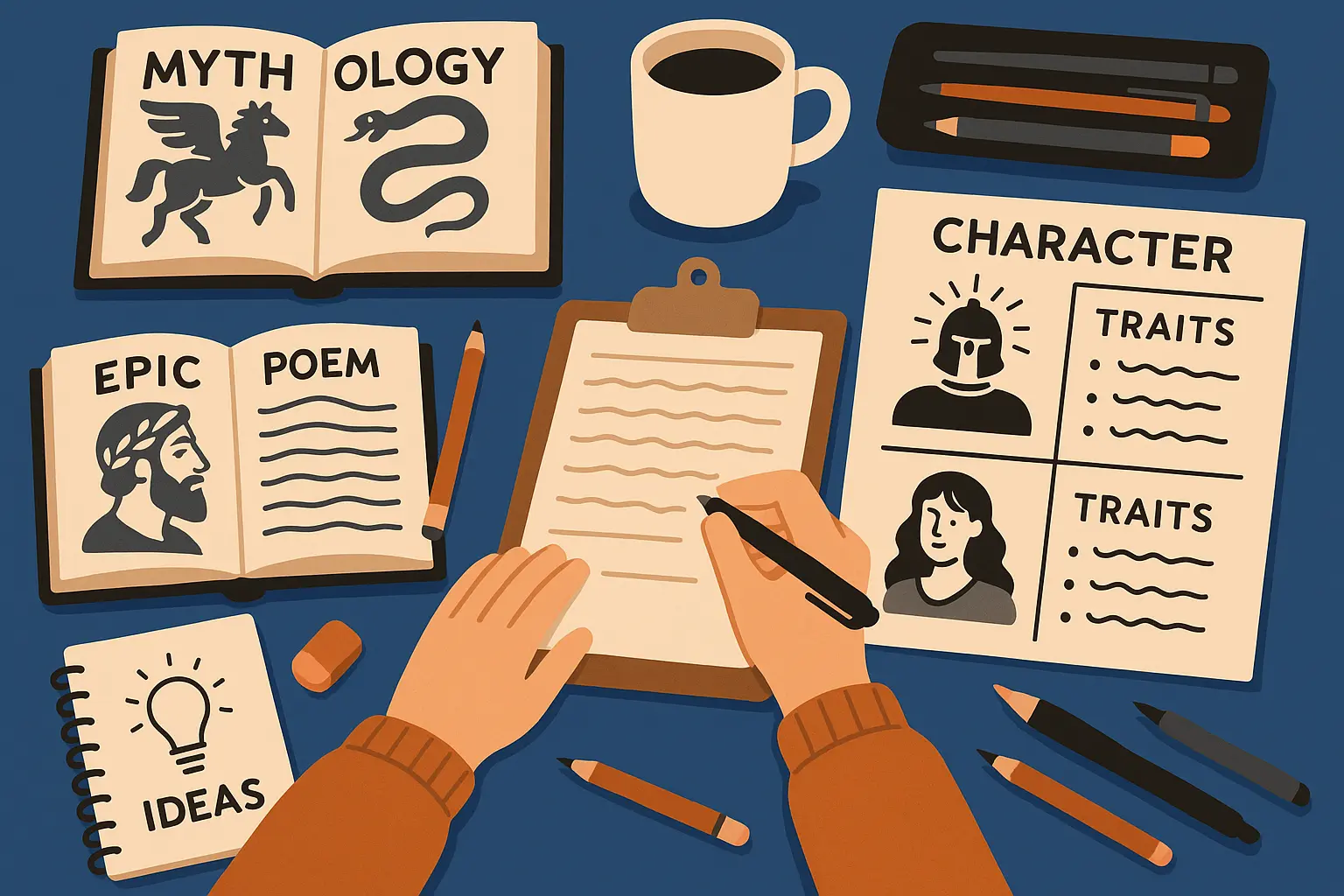
Final Thoughts
You know what strikes me most after going through all these interpretations? Loki endures because he represents something fundamentally human – the part of us that questions authority, that can’t quite fit in anywhere, that’s capable of both creation and destruction sometimes in the same action.
The evolution from ancient trickster to modern “God of Stories” isn’t just about updating old myths for new audiences. It reflects our growing understanding of how stories shape reality, how identity is something we construct rather than something fixed, and how the most interesting people are often the most contradictory ones.
Every generation finds something different in Loki because every generation faces different challenges. The Vikings saw a figure who embodied the creative chaos necessary for change. We see someone struggling with identity, family expectations, and the possibility of redemption. Future generations will probably find entirely different meanings that we can’t even imagine yet.
For writers and creators, these interpretations provide a masterclass in character development. They show how to create figures who can serve multiple narrative functions simultaneously, how to balance chaos with structure, and how to explore profound themes through entertaining stories.
The diversity of successful approaches proves there’s no single “correct” way to interpret mythological material. Creativity and respect for source material can coexist beautifully. The key is understanding what makes something work at its core, then finding new ways to express that essence.
Whether you’re drawn to Gaiman’s literary mastery, Marvel’s emotional character arcs, or the interactive possibilities of gaming, there’s a version of Loki out there that will speak to you. And if there isn’t? Well, that just means there’s room for you to create your own interpretation that captures what makes this thousand-year-old trickster god still relevant to our modern world.
The best stories, like the best mythological figures, aren’t just entertainment – they’re mirrors that help us understand ourselves and our world a little better. Loki, in all his contradictory glory, continues to serve that function across every medium and interpretation. That’s not bad for a character who started out cutting off a goddess’s hair as a prank.
If you’re inspired to create your own stories featuring complex, transformative characters, Nairrate’s AI Story Generator can help you develop narratives with the same depth and complexity that makes these Loki interpretations so compelling. Whether you’re crafting trickster characters, exploring themes of identity and transformation, or simply looking to break through creative blocks, our tools can help you discover the storytelling possibilities that lie within your imagination.



Add comment